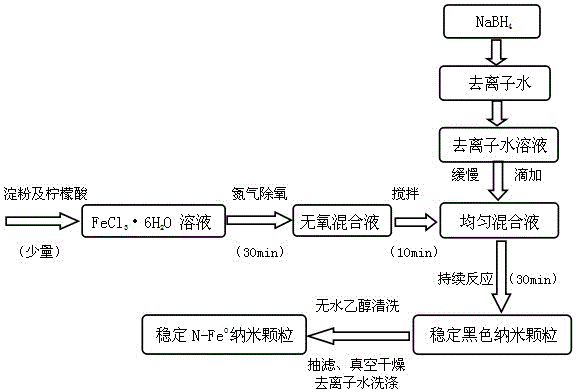Method for restoring hexavalent-chromium-polluted underground water by virtue of stable zero-valent iron nanoparticles
A nanoparticle and zero-valent iron technology, applied in the restoration of polluted soil, reduced water/sewage treatment, etc., can solve the problem of reducing chemical activity and achieve the effect of high reaction rate, high dispersion, and large specific surface area
- Summary
- Abstract
- Description
- Claims
- Application Information
AI Technical Summary
Problems solved by technology
Method used
Image
Examples
Embodiment 1
[0036] (1) Through data collection and on-site investigation, investigate the pollution status of groundwater and soil in typical heavy metal-polluted sites to understand the pollution status of heavy metal elements;
[0037] (2) Synthesis of stable nZVI:
[0038] 1) Add FeCl with a concentration of 0.8mol / L to a 250ml three-necked flask 3 ·6H 2 O solution 10mL, 0.1g starch and 0.2g citric acid, mechanically stir to make it fully mixed;
[0039] 2) Then weigh 3.79×10 -3 wxya 4 Dissolve in 10mL of deionized water to form an aqueous solution with a concentration of 0.757g / L;
[0040] 3) Under electric stirring at room temperature and normal pressure, slowly add it dropwise at a rate of 4mL / min to the FeCl 3 In the three-necked flask of the solution, the solution gradually turned black, and after the dropwise addition was completed, the reaction was continued for 30 minutes to generate stable black nano-iron particles;
[0041] 4) The product was washed three times with dei...
Embodiment 2
[0048] (1) Through the collection of data and on-site surveys, investigate the pollution status of groundwater and soil in typical heavy metal polluted sites in Shanxi to understand the pollution status of heavy metal elements;
[0049] (2) Synthesis of stable nZVI:
[0050] 1) Add FeCl with a concentration of 0.8mol / L to a 250ml three-necked flask 3 ·6H 2 O solution 10mL, 0.1g starch and 0.2g citric acid, mechanically stir to make it fully mixed;
[0051] 2) Then weigh 3.79×10 -3 wxya 4 Dissolve in 10mL of deionized water to form an aqueous solution with a concentration of 0.757g / L;
[0052] 3) Under electric stirring at room temperature and normal pressure, slowly add it dropwise at a rate of 4mL / min to the FeCl 3 In the three-necked flask of the solution, the solution gradually turned black, and after the dropwise addition was completed, the reaction was continued for 30 minutes to generate stable black nano-iron particles;
[0053] 4) The product was washed three tim...
Embodiment 3
[0060] (1) Through the collection of data and on-site surveys, investigate the pollution status of groundwater and soil in typical heavy metal polluted sites in Shanxi to understand the pollution status of heavy metal elements;
[0061] (2) Synthesis of stable nZVI:
[0062] 1) Add FeCl with a concentration of 0.8mol / L to a 250ml three-necked flask 3 ·6H 2 O solution 10mL, 0.1g starch and 0.2g citric acid, mechanically stir to make it fully mixed;
[0063] 2) Then weigh 3.79×10 -3 wxya 4 Dissolve in 10mL of deionized water to form an aqueous solution with a concentration of 0.757g / L;
[0064] 3) Under electric stirring at room temperature and normal pressure, slowly add it dropwise at a rate of 4mL / min to the FeCl 3 In the three-necked flask of the solution, the solution gradually turned black, and after the dropwise addition was completed, the reaction was continued for 30 minutes to generate stable black nano-iron particles;
[0065] 4) The product was washed three tim...
PUM
 Login to View More
Login to View More Abstract
Description
Claims
Application Information
 Login to View More
Login to View More - R&D
- Intellectual Property
- Life Sciences
- Materials
- Tech Scout
- Unparalleled Data Quality
- Higher Quality Content
- 60% Fewer Hallucinations
Browse by: Latest US Patents, China's latest patents, Technical Efficacy Thesaurus, Application Domain, Technology Topic, Popular Technical Reports.
© 2025 PatSnap. All rights reserved.Legal|Privacy policy|Modern Slavery Act Transparency Statement|Sitemap|About US| Contact US: help@patsnap.com


